Quick Look
Grade Level: 5 (3-5)
Time Required: 30 minutes
Lesson Dependency: None
Subject Areas: Earth and Space
NGSS Performance Expectations:

| 5-PS3-1 |
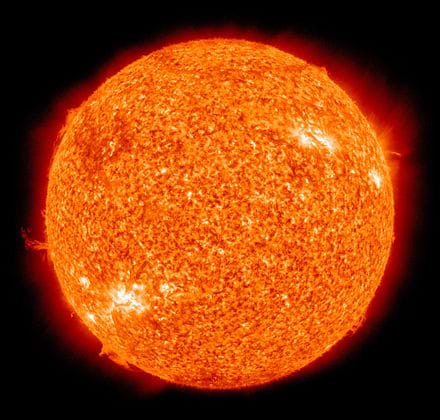
Summary
Students are introduced to our Sun as they explore its composition, what is happening inside it and its relationship to our planet (our energy source). Then students use the associated activities to relate engineering concepts and investigate solutions to harvesting the Sun's energy.Engineering Connection
Most of what we know about the Sun has come from telescopes and satellites that were designed by engineers. Aerospace engineers design, create, install and test systems for space-bound equipment and ships such as special telescopes that can look directly at the Sun. Aerospace engineers are not the only engineers who work in the space field; many other types of engineers also design and create spacecraft components, electronics, computer programs, life support systems as well as amazing telescopes.
Learning Objectives
After this lesson, students should be able to:
- Make the connection between the energy we use on Earth and energy from the Sun.
- List at least three different layers of the Sun.
- Describe how engineers help us learn about the Sun.
Educational Standards
Each TeachEngineering lesson or activity is correlated to one or more K-12 science,
technology, engineering or math (STEM) educational standards.
All 100,000+ K-12 STEM standards covered in TeachEngineering are collected, maintained and packaged by the Achievement Standards Network (ASN),
a project of D2L (www.achievementstandards.org).
In the ASN, standards are hierarchically structured: first by source; e.g., by state; within source by type; e.g., science or mathematics;
within type by subtype, then by grade, etc.
Each TeachEngineering lesson or activity is correlated to one or more K-12 science, technology, engineering or math (STEM) educational standards.
All 100,000+ K-12 STEM standards covered in TeachEngineering are collected, maintained and packaged by the Achievement Standards Network (ASN), a project of D2L (www.achievementstandards.org).
In the ASN, standards are hierarchically structured: first by source; e.g., by state; within source by type; e.g., science or mathematics; within type by subtype, then by grade, etc.
NGSS: Next Generation Science Standards - Science
| NGSS Performance Expectation | ||
|---|---|---|
|
5-PS3-1. Use models to describe that energy in animals' food (used for body repair, growth, motion, and to maintain body warmth) was once energy from the sun. (Grade 5) Do you agree with this alignment? |
||
| Click to view other curriculum aligned to this Performance Expectation | ||
| This lesson focuses on the following Three Dimensional Learning aspects of NGSS: | ||
| Science & Engineering Practices | Disciplinary Core Ideas | Crosscutting Concepts |
| Science explanations describe the mechanisms for natural events. Alignment agreement: | The energy released [from] food was once energy from the sun that was captured by plants in the chemical process that forms plant matter (from air and water). Alignment agreement: Food provides animals with the materials they need for body repair and growth and the energy they need to maintain body warmth and for motion.Alignment agreement: | Energy can be transferred in various ways and between objects. Alignment agreement: |
International Technology and Engineering Educators Association - Technology
-
Energy comes in different forms.
(Grades
3 -
5)
More Details
Do you agree with this alignment?
State Standards
Colorado - Science
-
Energy comes in many forms such as light, heat, sound, magnetic, chemical, and electrical
(Grade
4)
More Details
Do you agree with this alignment?
Introduction/Motivation
What is 25 million degrees Fahrenheit at its center (14 million degrees Celsius) and made of gas? You guessed it, the Sun! The Sun is a huge, hot ball of gas that is the center of our solar system. The Sun is so large that a million Earths could fit inside of it. While the sun has a relatively low average density, about 1.4 times the density of water, its large size causes it to have an incredible amount of mass. The large mass of the Sun means that it has a very powerful gravitational pull. (Note: The average density of the Sun is 1.4 times the density of water; the average density of the Earth is 5.5 times the density of water.)
The Sun is 93 million miles (150 million km) from our planet, but it still supplies us with almost all of the energy that we consume. The Sun's energy reaches the Earth in the form of heat, light and radiation. Without this energy, life could not exist on or planet. For example, all the fruits, vegetables and grains we eat use photosynthesis to turn energy from the Sun into energy for us. When we eat these plants we get the energy we need to walk, run, talk, throw, etc. We also eat animals that eat plants. The energy gets transferred from the plants to the animals and then to humans. Take a hamburger, for example. The lettuce, tomato, onion, bun, ketchup and mustard all come from plants. The egg in the mayonnaise comes from a chicken that gets its energy from eating plants. The hamburger comes from a cow that gets its energy from eating plants. As we can see, everything we eat gets its energy from the Sun. Without the Sun we would not be able to get the food we need to live.
So, what about other sources of energy? From where does the electricity we use in our houses and schools come? What about the energy to power our computers, lights, cars, trains, boats and planes? Most of the energy we use in our homes comes from burning fossil fuels such as coal and oil. Our transportation devices, such as automobiles, trains, boats and planes, almost all use fossil fuels (usually oil). Fossil fuels are made from decayed plants and animals from millions of years ago. From where do you think all those plants and animals got their energy? That's right — their energy came from the Sun. Other types of energy, such as solar, wind and hydroelectric, all require the Sun to provide power. Students can learn more about renewable energy applications with the activity, Cooking with the Sun: Comparing Yummy Solar Cooker Designs. Without the Sun, the Earth would be a frozen and dark ball with no life.
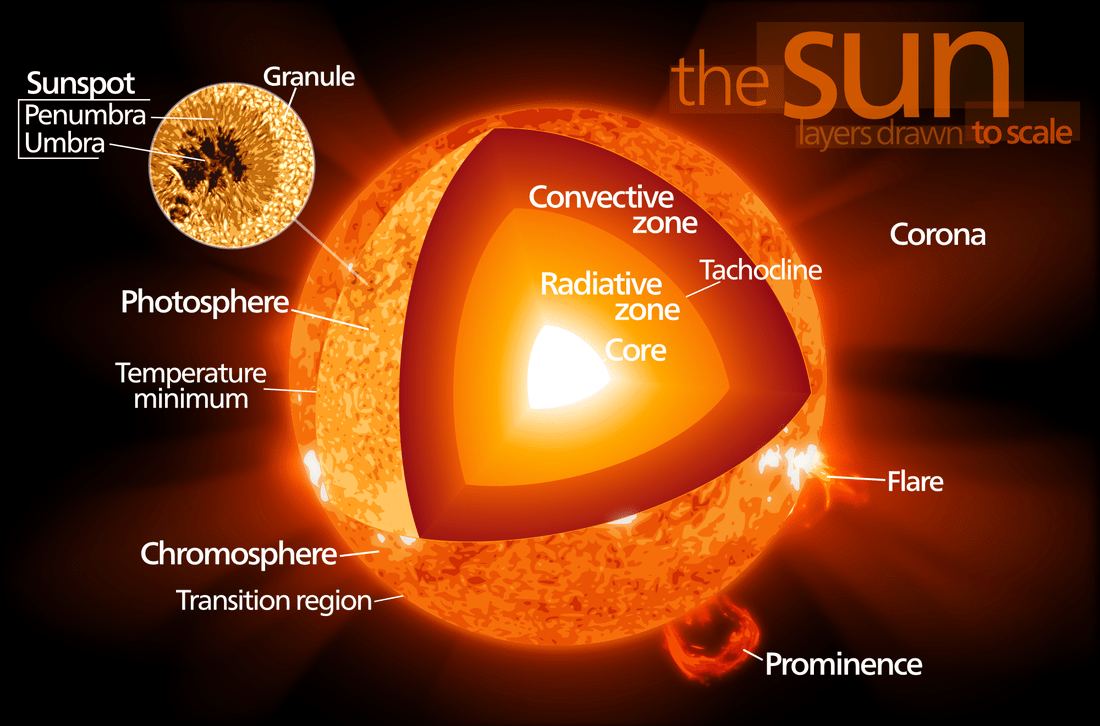
The Sun is not on fire like we think of fires on Earth. Oxygen is not required; the Sun is a big nuclear fusion reaction. If the Sun did behave like a fire on Earth, it would have burnt out long ago. So what keeps the Sun alive? The Sun is mostly made of hydrogen gas. This hydrogen is fused with other hydrogen to form helium. This process creates an immense amount of energy that we see as light and feel as heat. How long do you think it takes energy from the Sun to reach our planet? Because the Sun is so far away, it takes the energy from the Sun eight minutes to reach us on Earth. 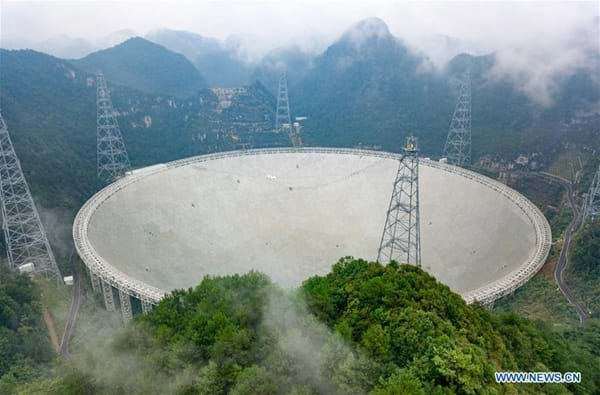
The Sun does not have a solid surface where we could stand, like on our planet. It has many different layers (see Figure 2). At the center is the core where the fusion of hydrogen takes place. Then, the energy passes through the radiative (or radiation) zone and the convection zone. The outermost layers of the Sun include the photosphere, chromosphere, and the corona. The visible surface of the Sun is the photosphere; it is from here that the light from the Sun comes. The next layer is the chromosphere, which is a thin layer of transparent hot gas around the photosphere. The outermost layer of the Sun is known as the corona. Humans can only view the corona with the naked eye during a solar eclipse (even then, one should never look directly at the Sun, as it can cause permanent eye damage). Teachers can use the Our Sun and Heat Transfer Basics: Heat It Up! activity to provide a demonstration of how heat moves from the core to the surface of the sun while also introducing students to three different types of heat transfer.
So, how have we learned so much about the Sun? Since people should not look directly at the Sun, we must create special devices that can look at the Sun for us and gather information for us. These devices include telescopes, cameras, sensors and satellites. These scientific instruments are designed and built by engineers. Huge ground-based telescopes are built by civil, mechanical and electrical engineers (see Figure 3). Aerospace, mechanical and electrical engineers design the satellites that look at the Sun and gather data from nearer the Sun. Without this scientific equipment we would not know everything we know about the Sun.
Lesson Background and Concepts for Teachers
A typical star, the Sun is ~865,000 miles (~1,392,000 km) in diameter (almost 10 times larger than Jupiter) and is composed primarily of hydrogen. A star is a ball of gas (actually plasma or an ionized gas, the fourth state of matter) held together by its own gravity. Our Sun is 4.5 billion years old and has used up half of the hydrogen in its core. It will continue to radiate for another 5 billion years, increasing its luminosity, until it runs out of hydrogen fuel.
Sunspots and the Solar Cycle — The Sun is often covered with dark spots known as sunspots. Sunspots are located in active regions of the Sun. Sunspots occur on an 11-year cycle, in which they go from none to more than 100 spots. When the solar cycle reaches a minimum, the activity on the Sun is at a minimum. Sunspots are actually cooler regions of the Sun. The temperature of a sunspot is about 3,700 degrees Kelvin, while the surrounding regions are around 5,700 degrees Kelvin. The lifespan of a sunspot can be a few days up to several weeks for large ones. Sunspots work like magnets; they come in pairs in which one is positive (north) and the other is negative (south). Sunspot areas produce strong magnetic fields.
Solar Magnetic Fields — The Sun produces a magnetic field from the flow of charged ions and electrons. Intense magnetic lines are produced at sunspots. The interior of the Sun recycles the magnetic fields during the 11-year Sun cycle. The magnetic field lines loop through the solar atmosphere and interior to form a complicated web of magnetic structures (see Figure 4).
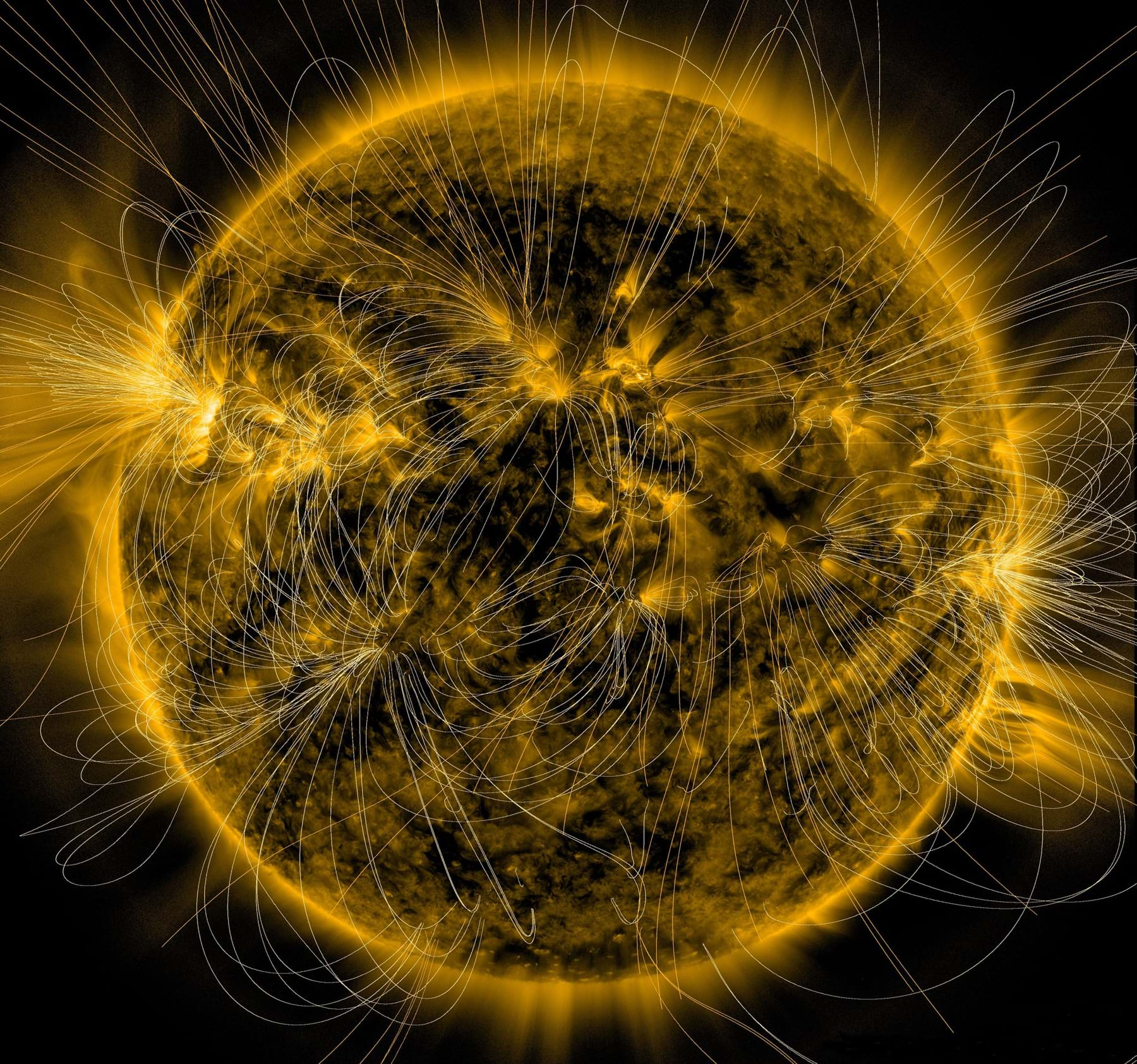
Solar Flares — Periodically, eruptions of energy occur from the surface of the Sun (see Figure 1). A flare is caused when magnetic field lines stretch and twist over sunspots on the surface until they build up enough energy to snap open, forming a tongue-like shape. According to NASA, these solar flares are the most energetic explosions in the solar system. They are so powerful that they can disrupt the Earth's atmosphere. In eight minutes, the energy release from the Sun reaches the Earth and causes our atmosphere to become ionized and expand. As a result, long-distance radio signals are disrupted, satellite orbits are disturbed and their electric satellite components can be damaged. Also, solar flares can be dangerous to astronauts and the electronic instruments on spacecraft.
Solar flares occur when the Sun releases magnetic energy that has been building up in the solar atmosphere. Since flares release unexpectedly, engineers and scientists look for ways to better predict when they occur. The amount of energy released is the equivalent to millions of 100-megaton hydrogen bombs exploding at the same time. Furthermore, the temperature of a flare typically reaches 10 to 20 million degrees Kelvin, but can rise to 100 million degrees Kelvin. Solar flares occur in active regions on the Sun and follow the Sun's 11-year cycle.
Coronal Mass Ejection — What travels at 2,000 km per second away from the Sun and can have catastrophic effects on the Earth? The answer is a coronal mass ejection (CME). CMEs are very large bubbles of gas that are ejected from the Sun over the course of several hours. They are not solar flares and can occur in the presence or absence of solar flares. Halo events are when a CME envelops the entire Sun. NASA observes two or three CMEs daily during the most active period of the solar cycle. Geomagnetic storms occur when CMEs collide with the Earth. If the storm is large enough, CMEs can disrupt power and damage communication satellites. Outside of the Earth's magnetic field, in space, CMEs cause damage to electronic equipment and astronauts.
Associated Activities
- Our Sun and Heat Transfer Basics: Heat It Up! - A teacher demonstration using water, heat and food coloring, helps students see how convection moves the contents of the Sun from the core towards the surface. Students also learn about the three different modes of heat transfer (convection, conduction, radiation) as related to the Sun
- Cooking with the Sun: Comparing Yummy Solar Cooker Designs - Students learn about using renewable energy from the Sun for heating and cooking as they build and compare the performance of four solar cooker designs. They explore the concepts of insulation, reflection, absorption, conduction and convection.
Lesson Closure
What is the most interesting thing you have learned about the Sun? Why is the Sun important to us on Earth? (Draw a diagram on the board of the path energy takes from the Sun to us. For example: Sun -> plant -> insect -> chicken -> human.) You can do that with any of the food we eat and the source of the energy is always the Sun. Even the energy our houses and vehicles and electronics use comes from the Sun. Let's name the layers of the Sun. (Draw a simple picture on the board and label each layer as the students name them: Core, radiative zone, convection zone, photosphere, chromosphere and corona; refer to Figure 2. Review the significance of the layers as you fill them in.) So, how do we know so much about our Sun? Can you name some devices designed by engineers to get closer to the sun, better observe the sun and learn more about the Sun? (Examples: Telescopes, cameras, satellites, spacecraft, satellites, sensors, measurement instruments.)
Vocabulary/Definitions
convection zone: The zone of the Sun at which energy is transported outward. This zone begins just below the photosphere and expands to about 70% of the solar radius.
corona : Outermost atmosphere of the Sun. (Typically a temperature of a few million degrees.)
coronal mass ejection (CME): Ejections of radiation and matter from the Sun.
engineer: A person who applies his/her understanding of science and math to creating things for the benefit of humanity and our world.
geomagnetic storm: Disturbance of the Earth's magnetic field caused by solar activity.
megaton: Explosive force equal to a million metric tons of TNT explosive.
radiation zone: The region of the Sun at which energy is transported towards the surface as electromagnetic radiation. Also called radiative zone.
solar flare: A sudden outburst of energy that occurs near magnetic fields on the Sun's visible surface. Flares emit ions, electrons and electromagnetic radiation.
sunspot: (Relatively) Dark and cool spots on the Sun that work like magnets.
Assessment
Pre-Lesson Assessment
Voting: Ask the students to vote on the following question:
- Could life exist on Earth without the Sun? (Answer: Life could not exist since almost all the energy on our planet comes from the Sun and energy is what enables us to live and grow.)
Post-Introduction Assessment
Discussion Question: Ask the students and discuss as a class:
- From where does the energy we use to watch television and run cars come? (Answer: Most of our electricity comes from the burning of fossil fuels such as oil and coal. Fossil fuels are decayed plants and animals from millions of years ago. Cars also burn fossil fuels; gasoline is a form of oil. The plants and animals that make up fossil fuels got their energy from the Sun.)
Lesson Summary Assessment
Numbered Heads: Divide the class into teams of three to five students each. Have the students on each team number off so each member has a different number. Ask the students a question and give them a time frame for solving it (~one minute). The members of each team should work together to answer the question. Everyone on the team must know the answer. Call a number at random. Students with that number should raise their hands to. If not all the students with that number raise their hands, allow the teams to work a give the answer little longer. Example questions:
- What is the Sun mostly made of? (Answer: Hydrogen)
- Does the Sun burn like wood on Earth? (Answer: No, the Sun is a fusion reactor.)
- What are the darker and cooler points on the Sun called? (Answer: Sunspots)
- Does the Sun have a magnetic field? (Answer: Yes)
- Name one of the phenomena on the Sun in which large quantities of energy are released into space. (Answers: Solar flare, coronal mass ejection.)
- Name one of the layers of the Sun's atmosphere. (Answer: Photosphere, chromosphere, corona.)
- Name one of the layers inside the Sun. (Answer: Core, radiation zone, convection zone.)
- How long does it take energy (that is, light and heat) to get from the Sun to our planet? (Answer: About eight minutes.)
- Name something that engineers design and create that helps us learn about the Sun. (Possible answers: Observatory, telescope, camera, satellite, scientific instrument, equipment, measurement device, sensor, spacecraft, etc.)
Lesson Extension Activities
Have students make a poster that shows how energy is transferred from the Sun to our houses, vehicles, electronics or bodies. As an extra challenge, have students brainstorm how the Sun creates hydroelectric power and wind power.
Have students experience the importance of the Sun on green plants by conducting the grade 5 (3-6) Plant Cycles: Photosynthesis & Transpiration activity at TeachEngineering.org.
Additional Multimedia Support
Learn about sun spots and solar flares at: https://spaceplace.nasa.gov/solar-activity/en/
See a short movie clip of a massive solar flare as captured by NASA. See: https://www.youtube.com/watch?v=GrnGi-q6iWc
See a gallery of solar images at NASA Science: https://solarsystem.nasa.gov/solar-system/sun/galleries/?page=0&per_page=25&order=created_at+desc&search=&href_query_params=category%3Dsolar-system_sun&button_class=big_more_button&tags=sun&condition_1=1%3Ais_in_resource_list&category=51
Subscribe
Get the inside scoop on all things TeachEngineering such as new site features, curriculum updates, video releases, and more by signing up for our newsletter!More Curriculum Like This

Students are introduced to the Sun by exploring various aspects of it, including its composition, interior workings, and relationship to the Earth.

Through role playing and problem solving, this lesson sets the stage for a friendly competition between groups to design and build a shielding device to protect humans traveling in space. The instructor asks students—how might we design radiation shielding for space travel?
References
Arecibo Observatory. National Astronomy and Ionosphere Center. Accessed January 22, 2007. http://www.naic.edu/
Couper, Heather and Nigel Henbest. How the Universe Works. London, UK: Dorling Kindersley Limited, 1994.
Engineers (nature of the work, working conditions, training, employment, job outlook, earnings, related occupations, etc.). Last modified October 25, 2006. U.S. Bureau of Labor Statistics, U.S. Department of Labor. Accessed January 3, 2007. http://www.bls.gov/ooh/
Fossil Energy: DOE's fossil energy-related education material. Updated November 17, 2006. Fossil Energy Office of Communication. U.S. Department of Energy. Accessed January 3, 2007. http://www.fe.doe.gov/education/
Hathaway, David H. Solar Physics. Updated January 3, 2007. Marshall Space Flight Center, NASA. Accessed January 3, 2007. (Sun facts) http://solarscience.msfc.nasa.gov/
Holman, Gordon and Sarah Benedict. Solar Flare Theory. Updated December 11, 2006. Laboratory for Astronomy and Solar Physics, Goddard Space Flight Center, NASA. Accessed January 3, 2007. (general information about solar flares) http://hesperia.gsfc.nasa.gov/sftheory/index.html
Kagen, S. Cooperative Learning. San Juan Capistrano, CA: Kagan Cooperative Learning, 1994. (Source for Numbered Heads assessment activity)
Mission Control: Living with a Star. Last updated March 18, 2006. SDO Education and Public Outreach Website, Goddard Space Flight Center, NASA. Accessed January 22, 2007. Previously found at http://sdoepo.gsfc.nasa.gov/mission/lws.shtml
Sun. Worldbook @ NASA. Accessed January 22, 2007. http://www.nasa.gov/worldbook/sun_worldbook.html
Space Technology 5: Tomorrow's Technology Today. Updated January 2004. NASA. Accessed January 22, 2007. https://docs.google.com/viewer?a=v&q=cache:2uflDIIwCoUJ:spaceplace.nasa.gov/review/posters/st5_litho/st5_litho.pdf+&hl=en&gl=us&pid=bl&srcid=ADGEEShJb79f6OxWQ-ibe7hutA_zVzUd9rX6rzMWhRATUlJJL3ALs4xOQgbYIaSWBGkFM-iqQx-PeYKnTOJ6W1K10XwUZPV-65frQ4fT8UHlOKIjRXIJxwN5TX5mEe_UtVx8AuRx7EdK&sig=AHIEtbT7rCT4f5_NJCDnkpFTA9Hmu6EEUQ
Copyright
© 2006 by Regents of the University of Colorado.Contributors
Jessica Todd; Geoffrey Hill; Jessica Butterfield; Denise W. CarlsonSupporting Program
Integrated Teaching and Learning Program, College of Engineering, University of Colorado BoulderAcknowledgements
The contents of these digital library curricula were developed by the Integrated Teaching and Learning Program under National Science Foundation GK-12 grant no. 0338326. However, these contents do not necessarily represent the policies of the National Science Foundation, and you should not assume endorsement by the federal government.
Last modified: November 1, 2021






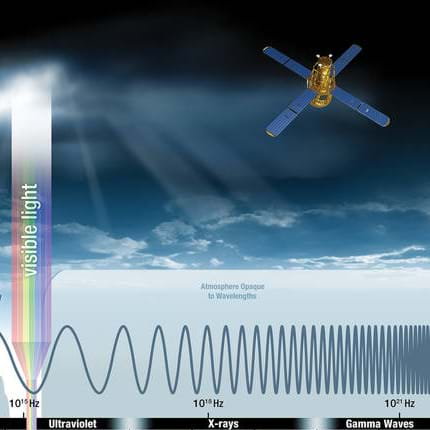
User Comments & Tips